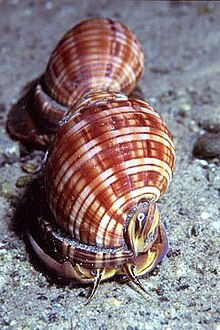Scotch bonnet (sea snail)
| Scotch bonnet | |
|---|---|
 |
|
| Five views of a shell of Semicassis granulata granulata | |
 |
|
| Two live individuals of Semicassis granulata undulata in Archi, Reggio Calabria, Italy | |
| Scientific classification | |
| Kingdom: | Animalia |
| Phylum: | Mollusca |
| Class: | Gastropoda |
| (unranked): | clade Caenogastropoda clade Hypsogastropoda clade Littorinimorpha |
| Superfamily: | Tonnoidea |
| Family: | Cassidae |
| Subfamily: | Cassinae |
| Genus: | Semicassis |
| Species: | S. granulata |
| Binomial name | |
|
Semicassis granulata (Born, 1778) |
|
| Synonyms | |
|
List of synonyms
|
|
The Scotch bonnet, scientific name Semicassis granulata, is a medium-sized to large species of sea snail, a marine gastropod mollusk in the subfamily Cassinae, the helmet shells and bonnet shells. The common name "Scotch bonnet" alludes to the general outline and color pattern of the shell, which vaguely resemble a tam o' shanter, a traditional Scottish bonnet or cap. The shell is egg-shaped and fairly large, 2 to 4 inches (5 to 10 cm) in maximum dimension, with a regular pattern of yellow, orange or brown squarish spots. The surface sculpture of the shell is highly variable: the surface can be smooth and polished, have grooves, be granulated, or even be nodulose on the shoulder of the whorls.
This species lives intertidally and subtidally on sandy substrates, and is found primarily in the tropical and subtropical Western Atlantic Ocean, from North Carolina to Uruguay. It is the most common species in this subfamily in North America. A similar-appearing sea snail in the Mediterranean Sea and Northern Atlantic Ocean, Semicassis granulata undulata, is currently considered to be a subspecies. The exact taxonomy of this species has been unclear in the past: as well as the current combination Semicassis granulata, 38 other combinations and synonyms exist.
In the spring, the adult females of this species lay eggs in tower-shaped structures. The eggs hatch as veliger larvae, which can float in the plankton for up to 14 weeks before settling onto the seabed as tiny snails. Crabs are a predator of this sea snail. After the death of the snails, if the shells are still intact they are often used by hermit crabs.
...
Wikipedia
